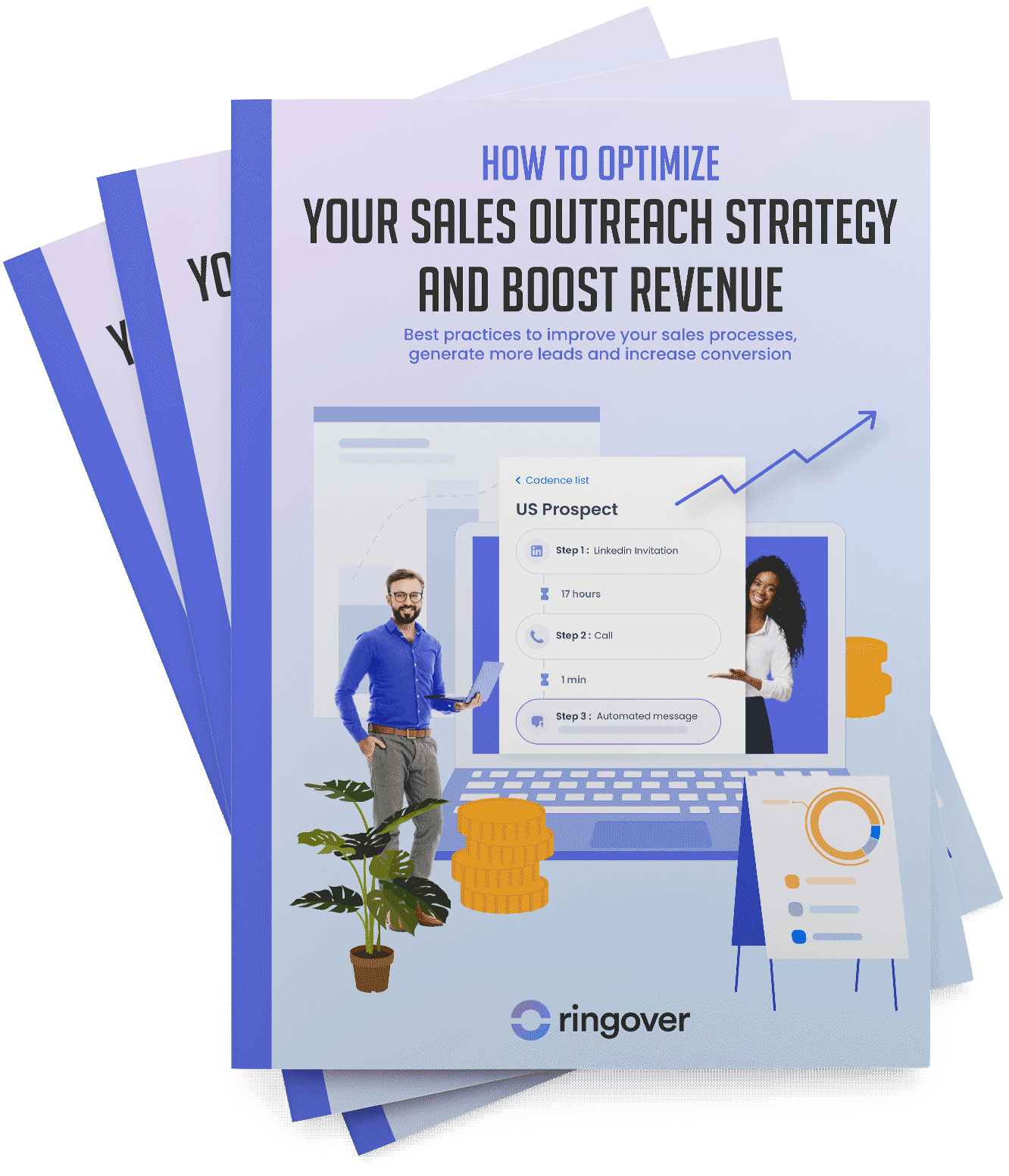Summary
The purpose of sales follow-up is to improve the buying experience and foster the conversion of prospects into customers. In this article, we will show you the essence of sales follow-up, explain why it is essential for your company's growth, how to implement it effectively, and the steps to ensure its effectiveness over time and achieve sales closings.
We will also share useful tips and tools to improve your sales follow-up process and thereby increase your profits. Keep reading to discover all the secrets of this sales stage!
What is Sales Follow-Up?
Sales follow-up is a crucial management technique that allows companies to evaluate and improve their sales process. This strategy involves continuous tracking, analysis, and monitoring of sales data, providing a comprehensive and detailed view of your sales team's performance, usually thanks to an outbound call centre software.
Definition and Key Components
Sales follow-up is the process of monitoring and evaluating the progress of a sale, from the first contact with a potential customer to the closing of the sale and beyond. It is a key sales prospecting tool in commercial management that allows companies to evaluate and optimise their sales cycle.
During follow-up, a detailed analysis of each stage of the sales process is conducted, and indicators are used to measure goal achievement and make decisions based on the collected information.
It is important to perform effective sales follow-up to visualise the return on investment of each implemented strategy and ensure that primary and secondary KPIs are in place to cover all aspects of sales tracking–especially useful when looking at SaaS metrics to evaluate software sales.
Among the fundamental components of sales tracking are:
- Potential customers or leads, individuals who show interest in the product or service offered.
- Contacts or prospects, those potential customers who have provided their contact information and have given permission to be approached.
- Opportunities or deals, contacts who have shown a clear intention to purchase and are qualified for it.
- Closures, opportunities that have turned into actual customers after making a purchase.
- Customers, people who have purchased the product or service and who can generate repeat purchases or referrals.
Difference Between Sales Follow-Up and Sales Management
Although closely linked, sales tracking and sales management are not the same. Sales management encompasses the set of operations carried out to coordinate, organise, direct, and supervise the sales flow of a company.
Sales management involves defining sales objectives, allocating resources, selecting and training the sales team, evaluating their performance, and motivating the salespeople.
In contrast, sales tracking is a specific function within sales management, focused on the analysis and monitoring of sales information. This activity supports sales management in making informed decisions, identifying areas for improvement, solving problems, and optimising the sales process.
Why Effective Follow-Up is Crucial
Performing effective sales tracking is essential because it not only allows you to closely monitor and analyse your sales process but also brings significant advantages that can boost your company's growth. Below, we highlight two major benefits of implementing successful sales tracking.
Improvement of Customer Relationship
Sales tracking allows you to gain a deep understanding of your potential customers and their needs, which facilitates providing personalised service tailored to their expectations. This helps build trust and satisfaction among customers, increasing the likelihood that they become loyal buyers.
Moreover, through constant and effective communication with your customers, you can anticipate and resolve their concerns in a timely manner, adding value to your offer. This strategy not only helps you stand out from the competition but also strengthens your long-term relationships with customers.
Optimization of the Sales Cycle
Well-executed sales tracking allows you to refine the sales cycle; that is, reduce the time from when a prospect shows interest in your product or service until the purchase is finalised. By identifying the phases that require more attention, the challenges your customers face, and the areas for improvement within your sales process, you can fine-tune your strategies, automate processes, and streamline the sales cycle. This translates into increased revenue and reduced operating costs.
Make sales follow-up simple with an omnichannel communications contact centre software which allows you to reach prospects on the right channel, at the right time.
How to Implement Successful Sales Follow-Up
You already know the importance of sales tracking for the success of your business. But how do you implement it effectively in your team? Here we offer you three key elements to achieve it.
Choosing the Right Tool
For effective sales tracking, it is essential to have a tool that allows you to manage your customer, contact, opportunity, and closure data in an organised way. You need a platform that facilitates access to information, results analysis, and task automation, as CRM tools can do.
A CRM is vital for managing the entire sales cycle, from the first contact to loyalty. It allows you to record and update customer information, manage your sales team's activities, send quotes and invoices, follow up via , and generate detailed reports, among other functions.
There is a wide variety of CRMs available, each with different features and prices. The crucial thing is to choose one that perfectly fits the needs and objectives of your business. Some of the most used CRMs are Salesforce, HubSpot, Zoho, and Pipedrive.
Not only is a competent CRM necessary, but it is also essential to have an omnichannel communication solution and virtual switchboard with which to manage all your company's communications, especially your sales team.
Ringover is a good tool for sales follow-up due to its capabilities to enhance the results of call campaigns and to track all interactions, facilitating second or third contacts.
On the other hand, it also offers an advanced sales enablement tool with conversation intelligence software, which allows automatically identifying topics and detailed information to increase the productivity and efficiency of sales and customer service teams.
Additionally, by choosing such software, teams can optimise various aspects of the business, such as increasing the speed of calls through multichannel prospecting that facilitates contacting a larger number of potential customers more quickly.
Ringover Button
Develop a Clear Process
Defining a clear and standardised process for your sales team is another key to successful sales tracking. This should include the phases of the sales cycle, the criteria for qualifying customers, specific follow-up actions, and indicators to measure and evaluate performance.
A defined sales process helps to have a complete understanding of the sales funnel, identify opportunities and challenges, and improve your team's efficiency and productivity. Consider these steps when developing your sales process:
- Analysis of your market, target audience, and value proposition.
- Definition of the stages of the sales cycle, from lead generation to loyalty.
- Establishment of criteria to qualify potential customers.
- Design of personalised follow-up actions and messages.
- Setting of follow-up times and frequencies adapted to your customers.
- Selection of indicators to evaluate the results of the follow-up.
Training and Adoption by the Team
Finally, training and motivating your sales team to adopt and correctly use the tracking system is fundamental. It is useless to have tools and processes if your team does not understand, accept, or apply them properly.
To ensure successful adoption by your team, follow these steps:
- Explain the benefits of the tracking system for both the business and the team.
- Demonstrate how to use the tool and the tracking process, resolving doubts and issues that arise.
- Set clear and realistic goals and recognize the team's achievements.
- Monitor the use of the system and provide constant feedback and support.
By implementing these recommendations, you will create an effective sales tracking system that will contribute to increasing your sales and customer loyalty.
Conclusion: Ensuring Long-Term Success
We have just shown you the importance of sales tracking and why it is fundamental to your company's success. Implementing effective sales tracking not only improves your relationship with your customers but also optimises the sales process and contributes to greater revenue generation. To achieve this, it is essential to have the right tools, establish clear processes, and ensure that your sales team is well trained and motivated.
Knowing how to perform proper sales tracking is the first step toward the long-term success of your business. We encourage you to apply this knowledge in your company. Do not miss the opportunity to reinforce your company's ongoing success with effective sales tracking and a successful tool like Ringover. Take a free trial and discover for yourself the power of VoIP-based communication for your business.
Published on July 17, 2024.



